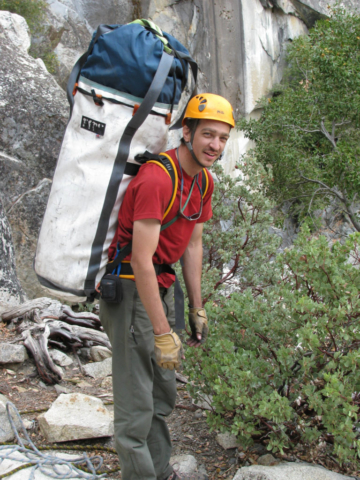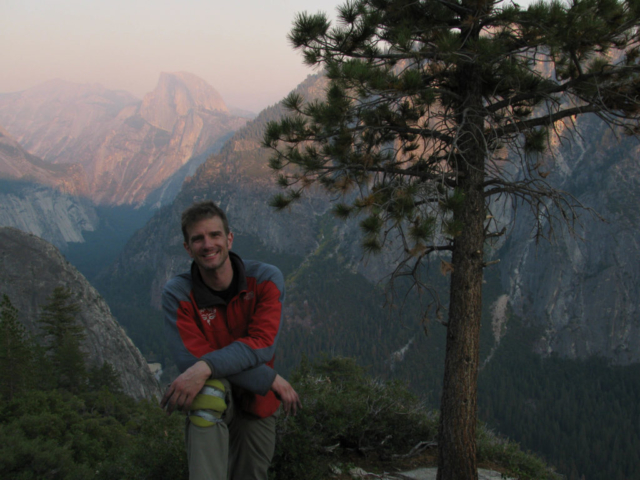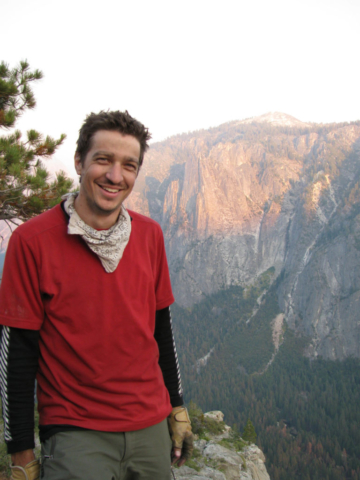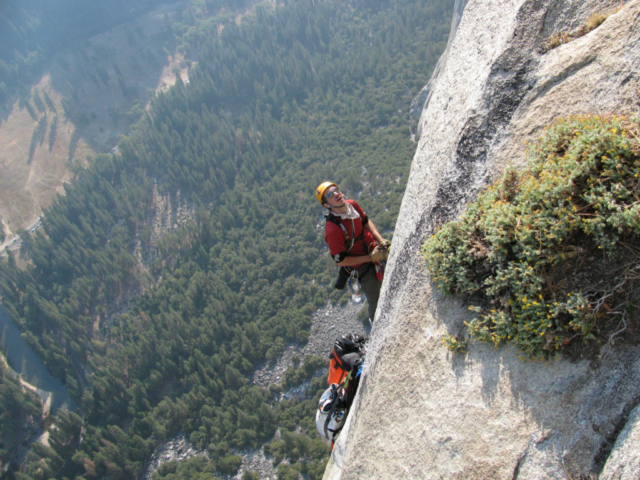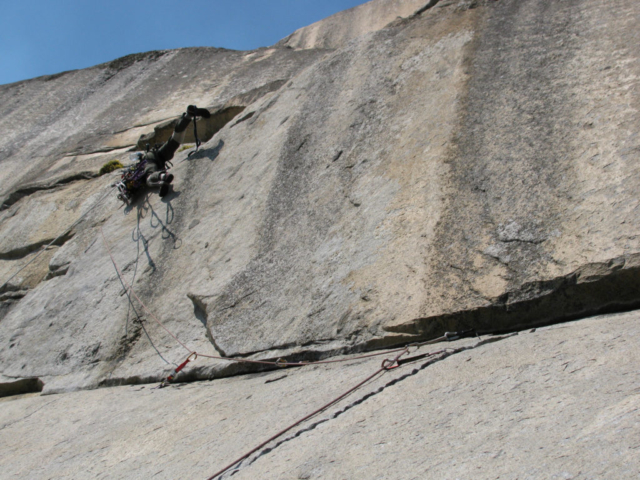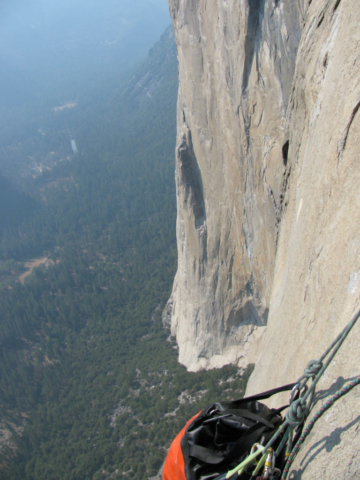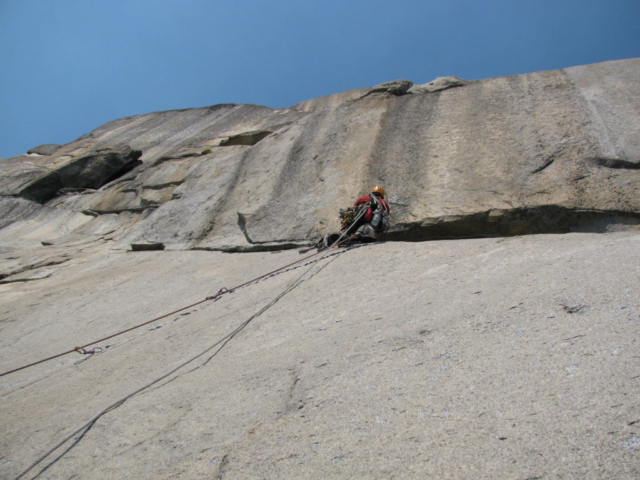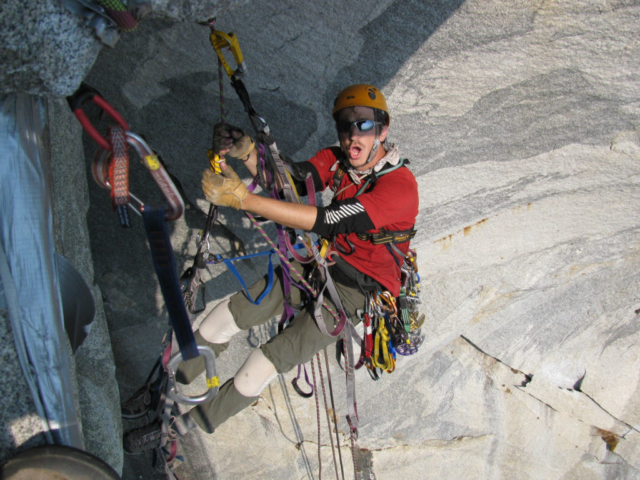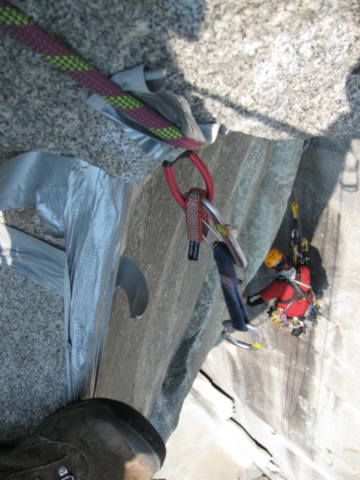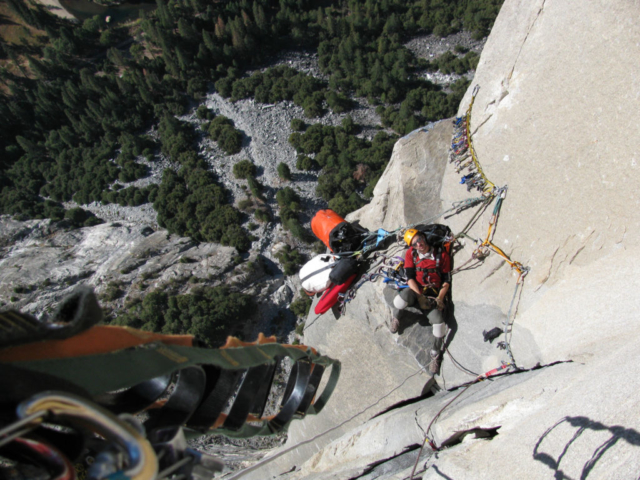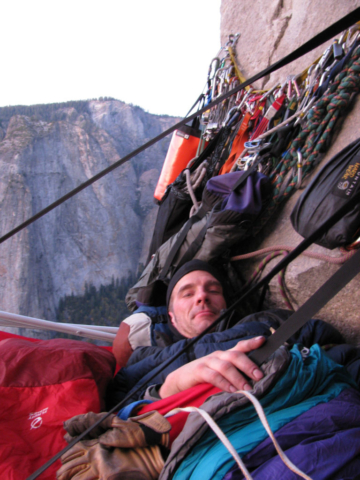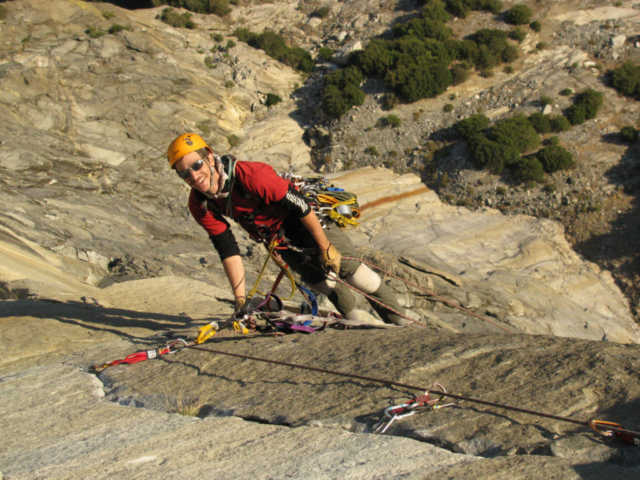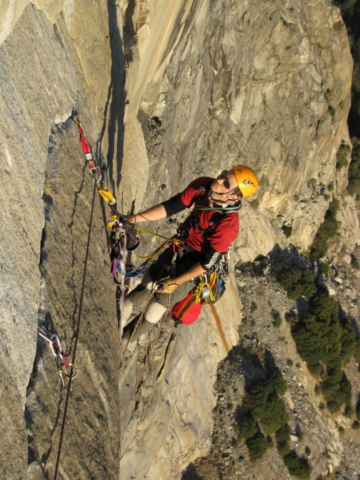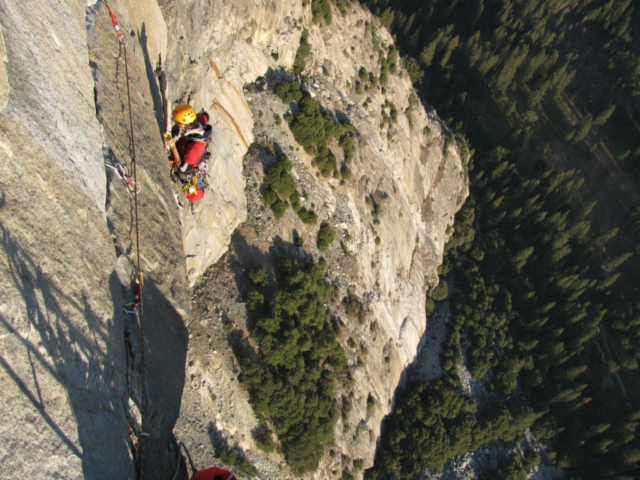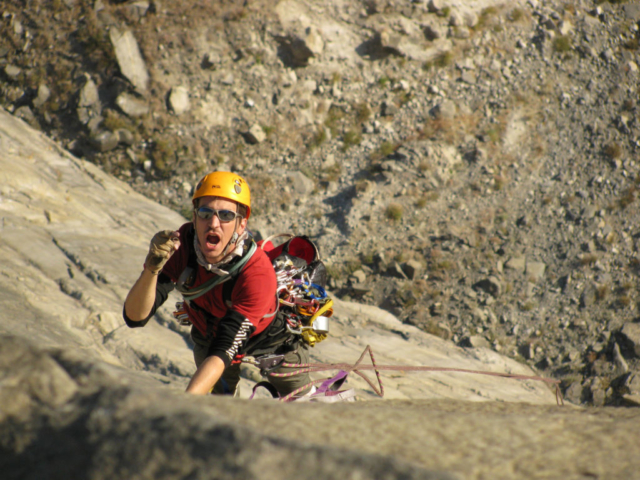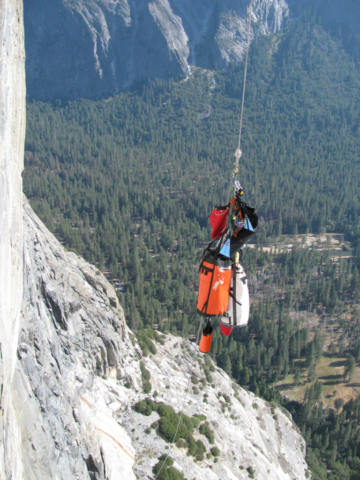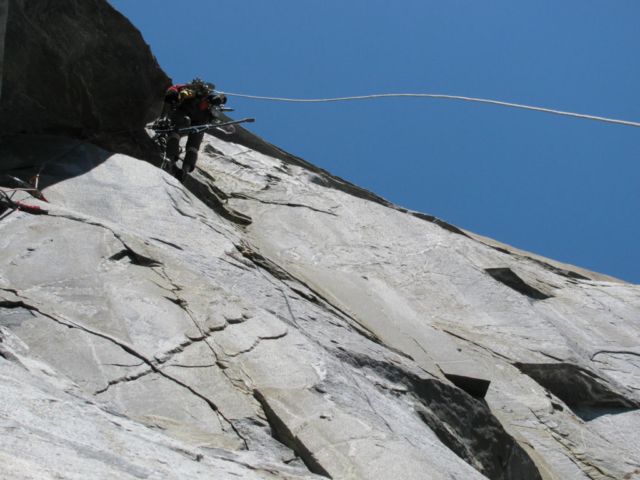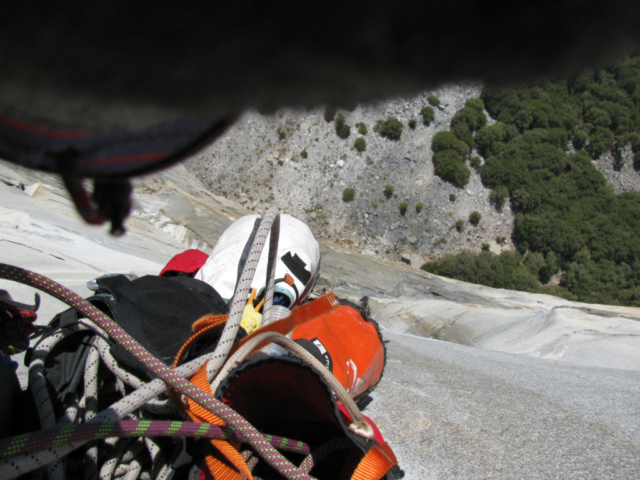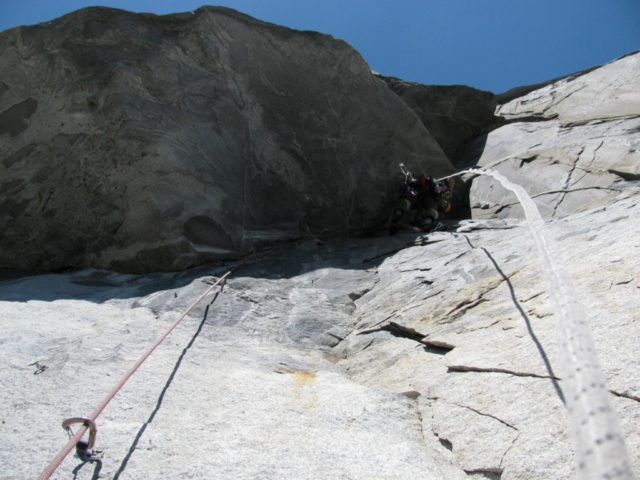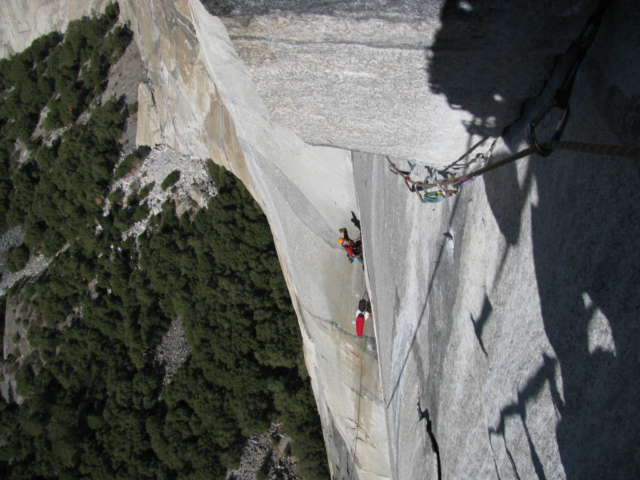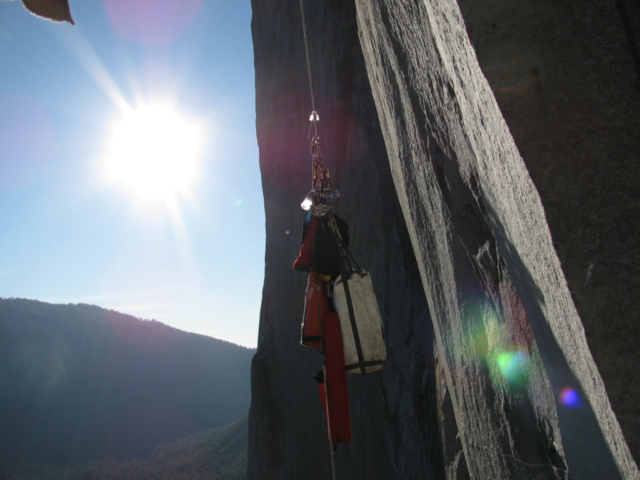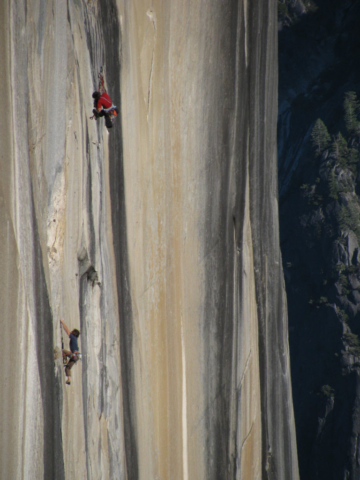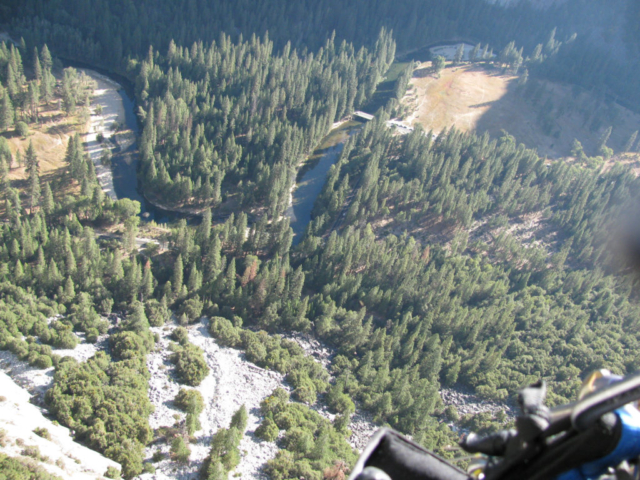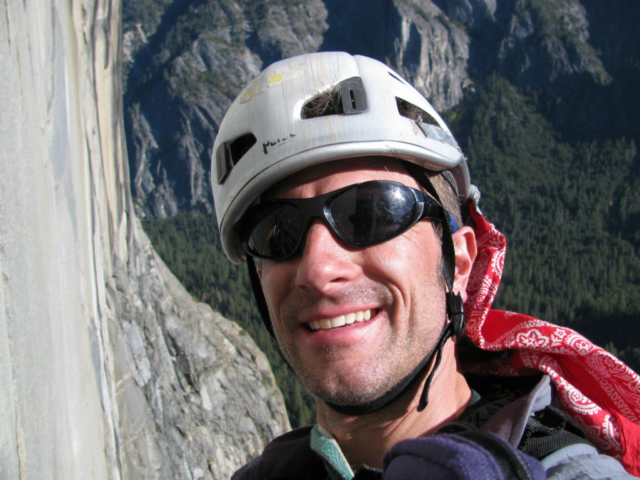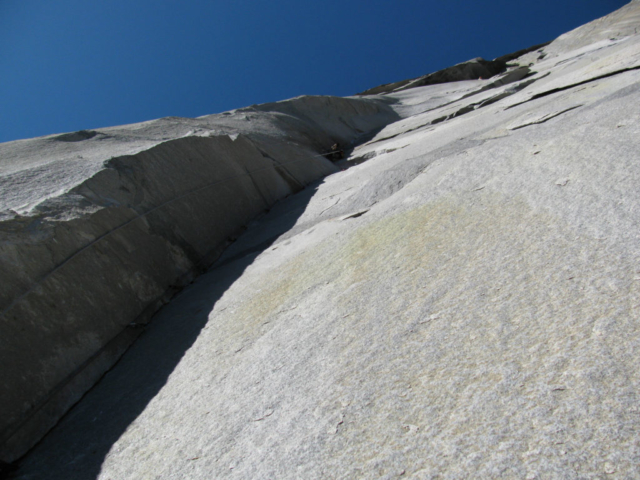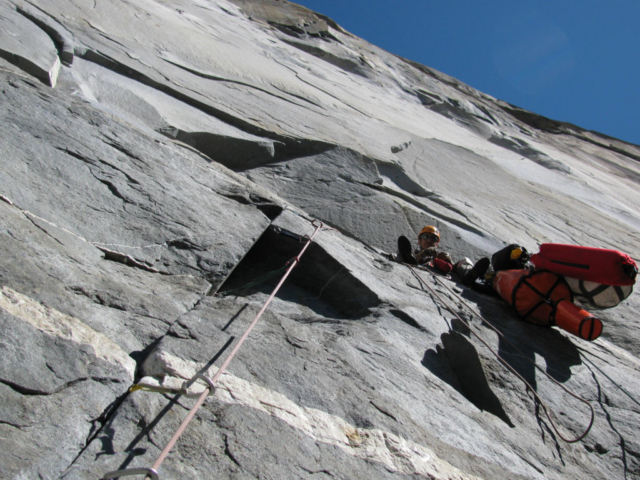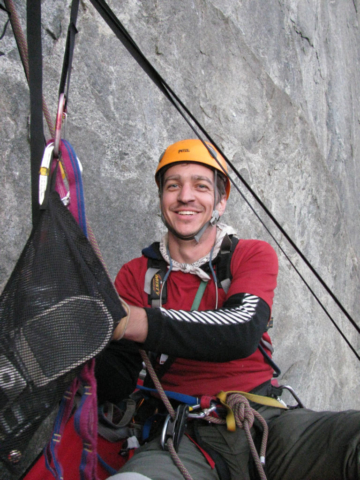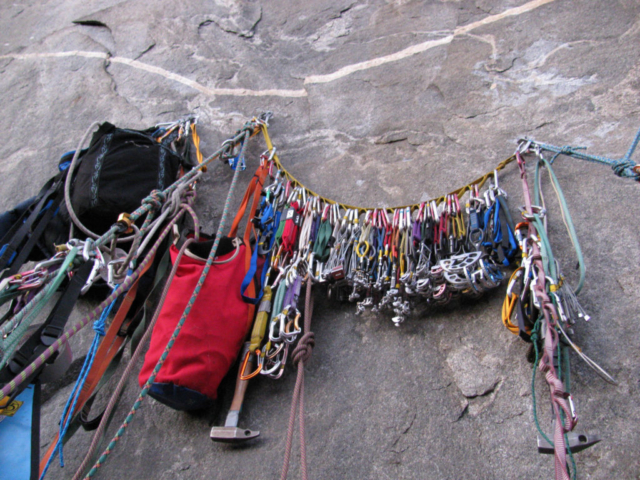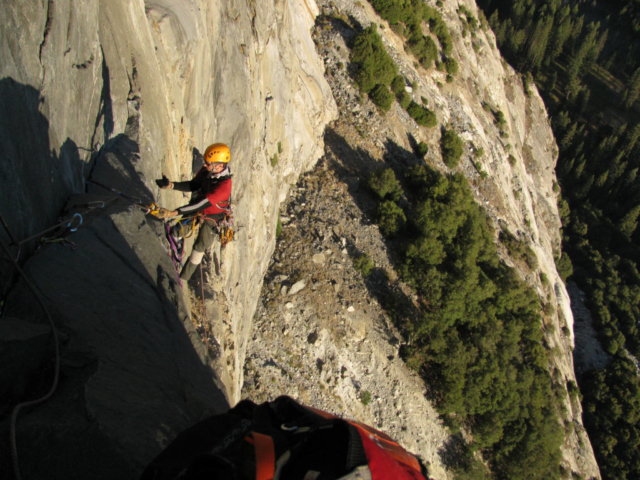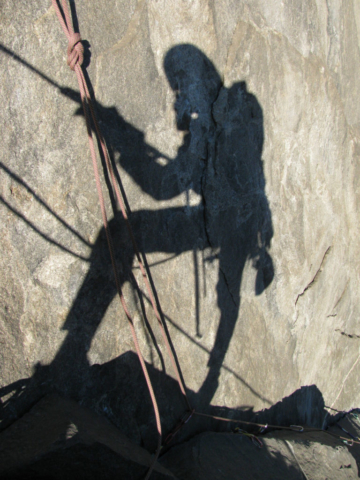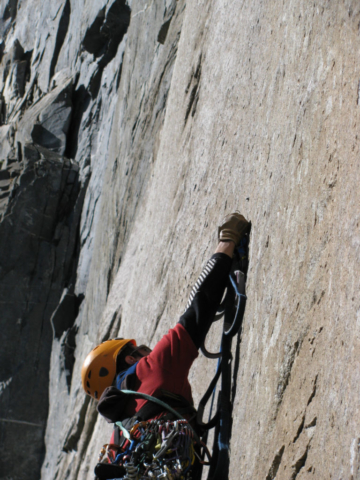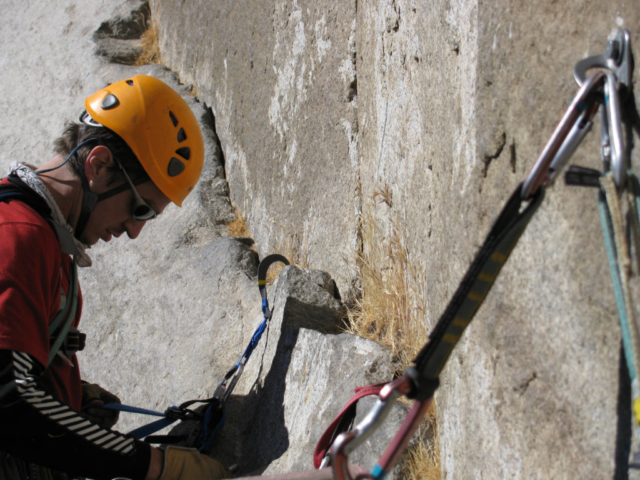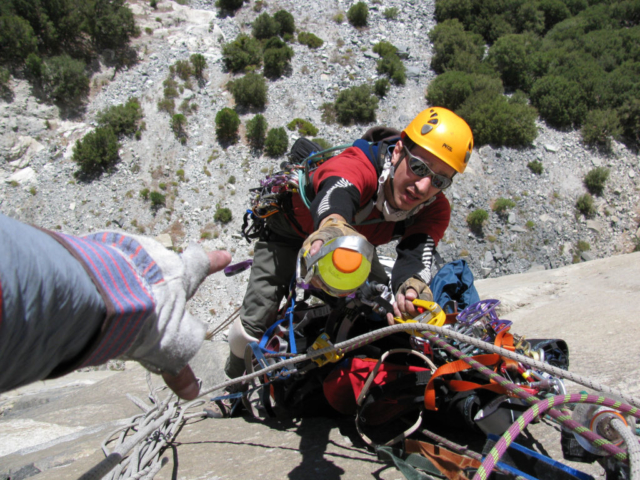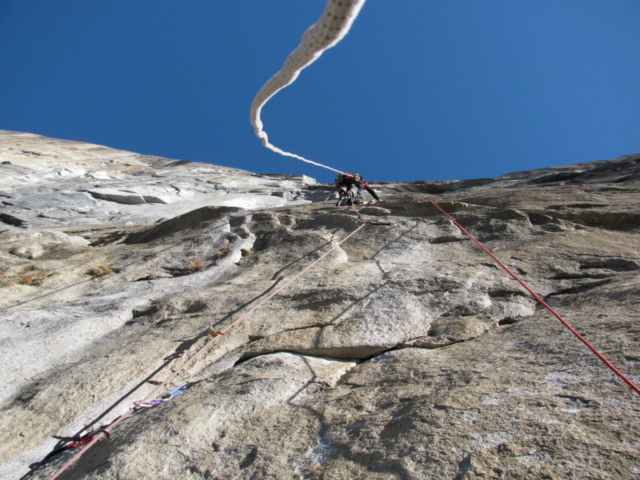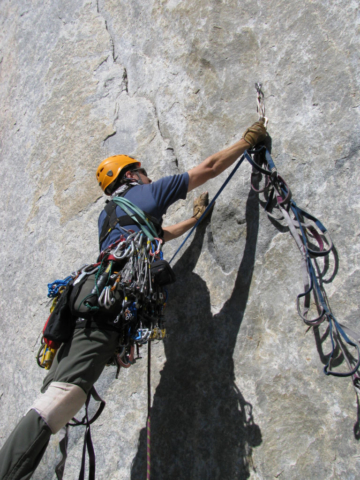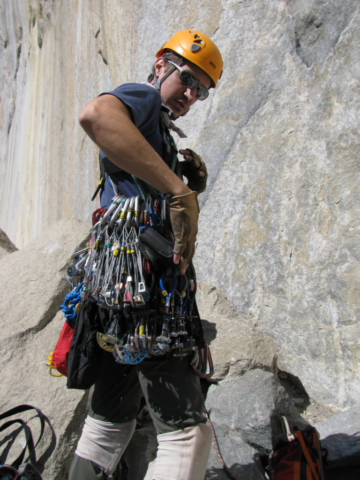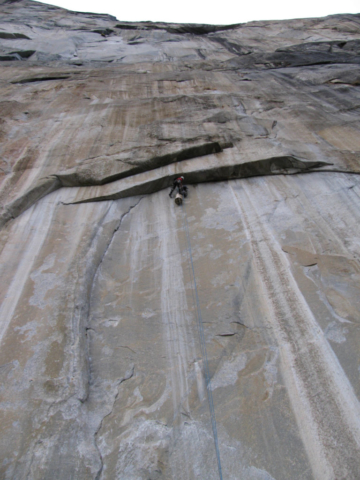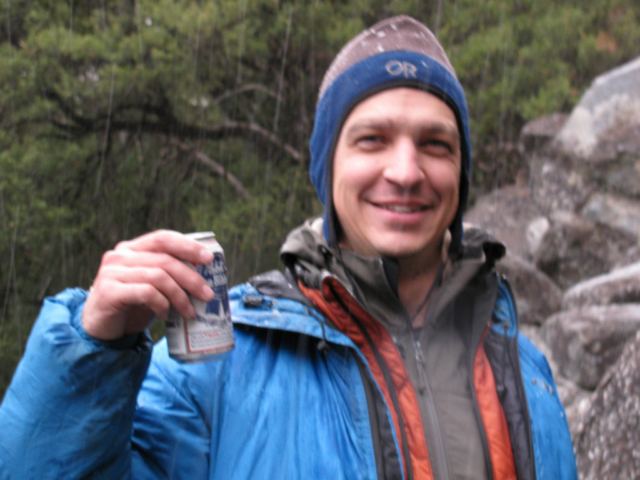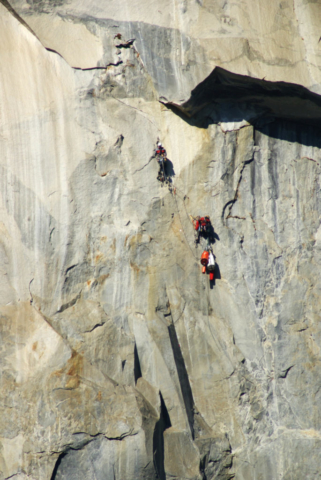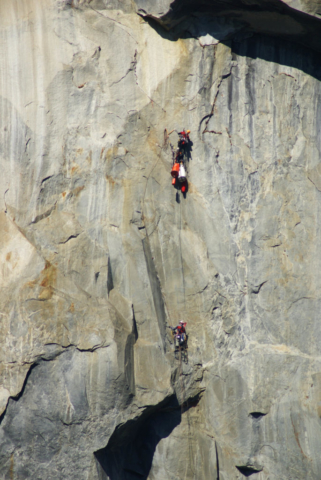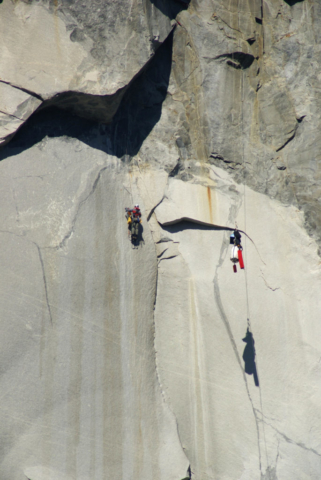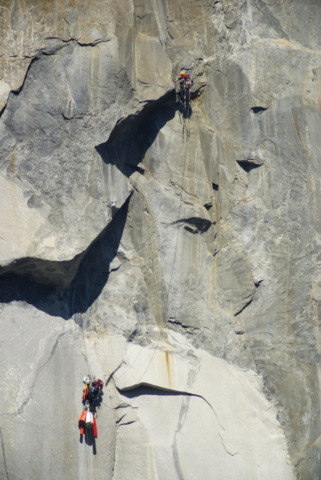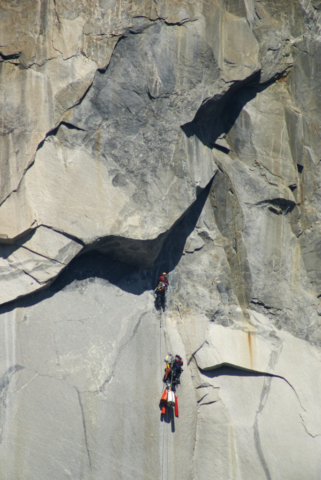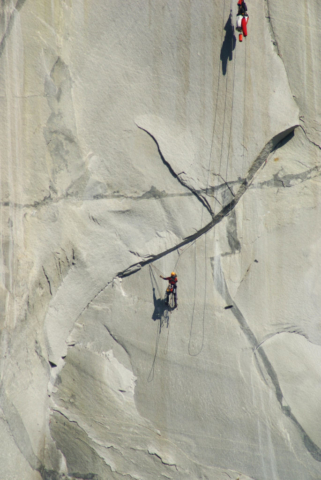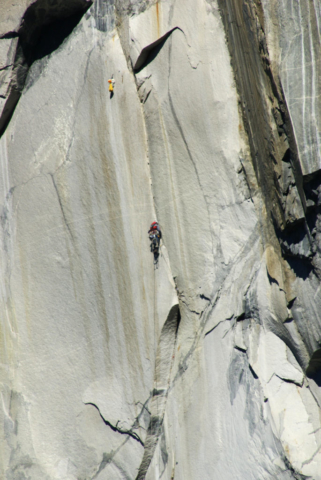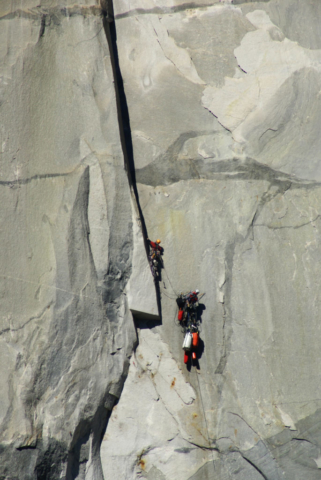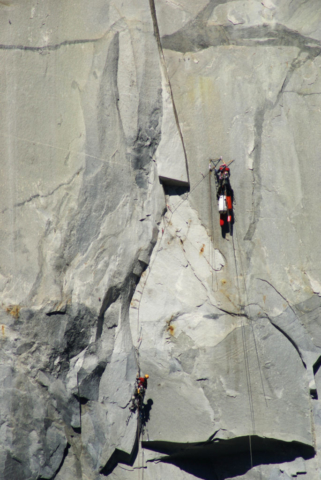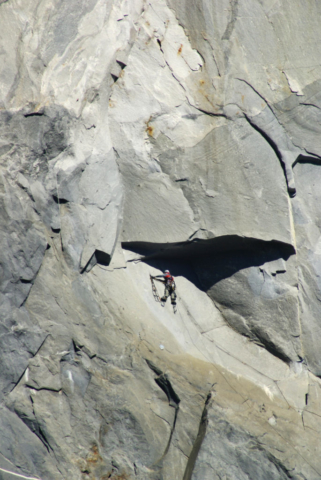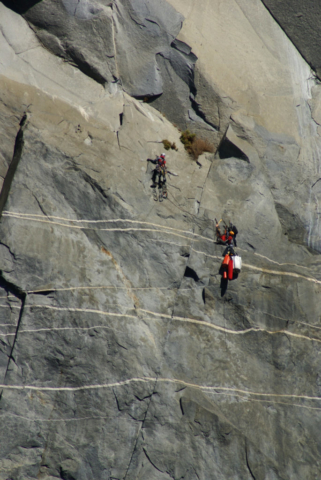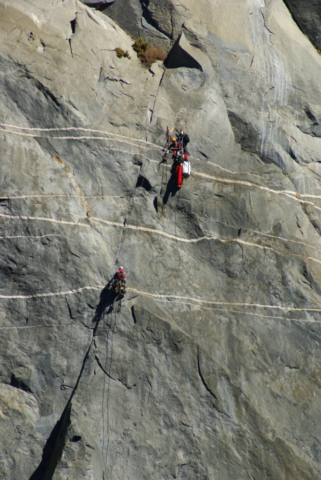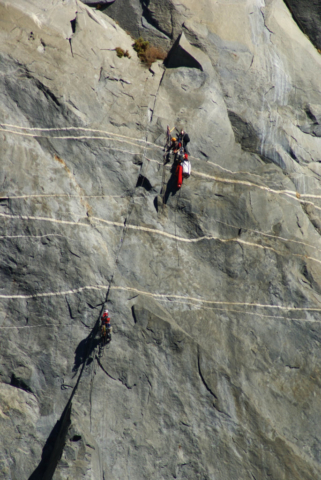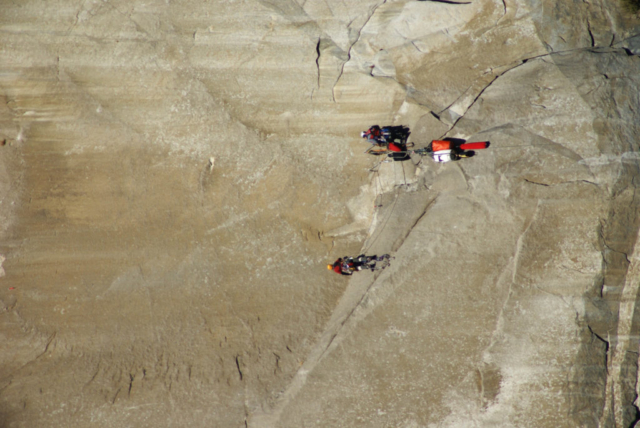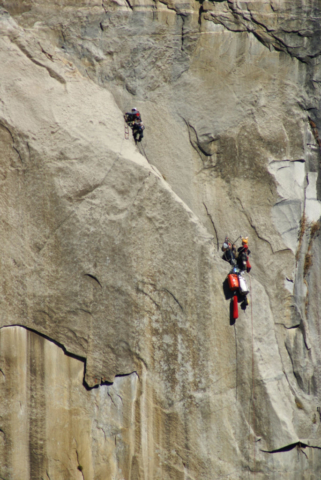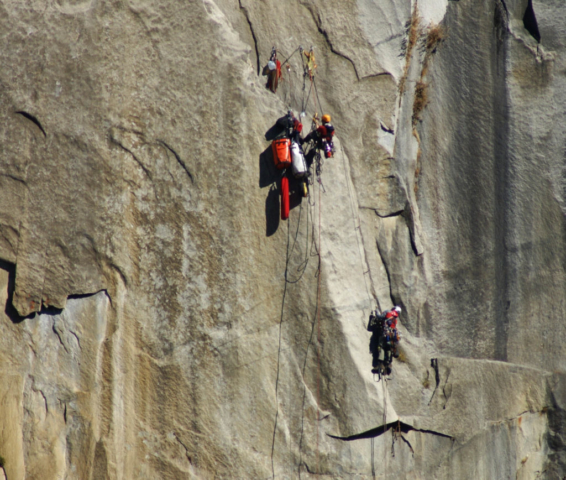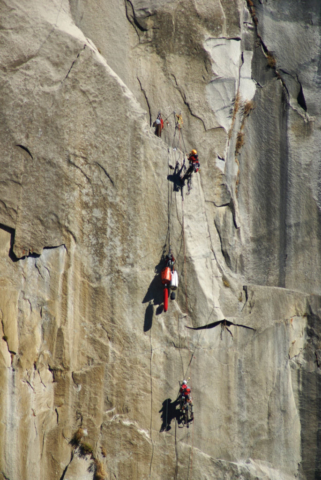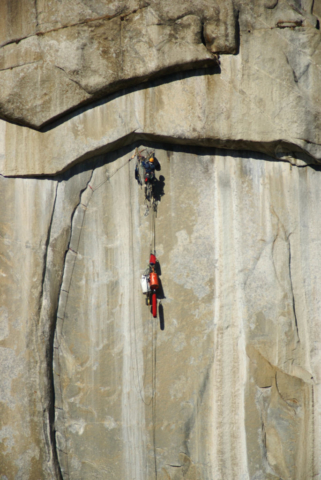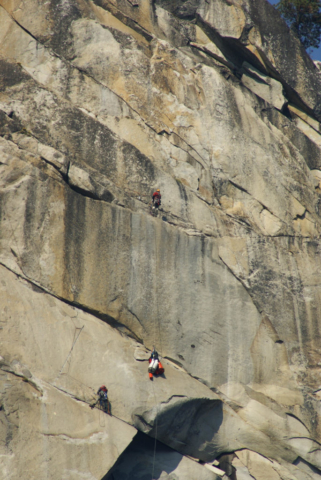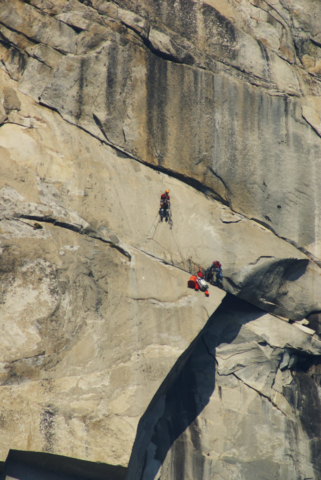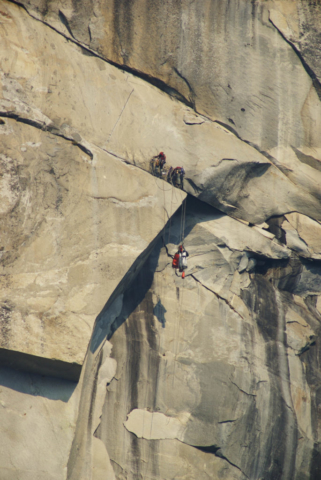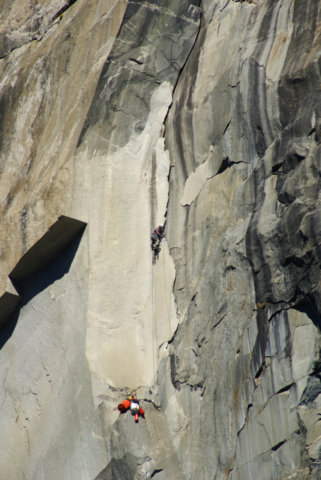📍 The Zodiac, El Capitan, Yosemite
📅 October 10-16, 2008
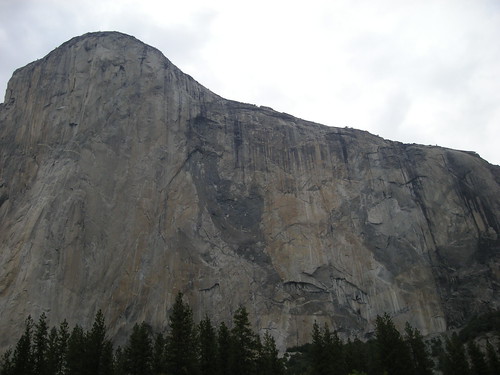
The first thing we did was hike to the base of the route to get a feel for what was in store. It was FREEZING! We took the talus “direct” approach, in hats, gloves and puffy jackets.
We inspected the route. Just like everybody says, the first move is a hook! It’s really no big deal, as the hook placement is so worn and in-cut, and leads to a not so reachy ASCA bolt ladder. The route looked really good. We could follow almost every pitch with our eyes to the top of the white circle. It actually looked “doable”, unlike more elusive or hidden routes, like The Nose maybe. Despite the cold and wet conditions, I was more encouraged than discouraged.
We spent the next two days, packing food, sorting gear, strategizing, and driving in circles from bear box to bear box. At one point in time, we had stuff in four bear boxes simultaneously, and more stuff in our haul bags that were at the top of pitch 2. Here’s a good noob move; don’t pack your wallet in the haul bags when you fix the first pitches. You’ll most likely want your money for dinner that night!
When we showed up with all the pigs and gear to fix the first two pitches, there was a party already on the “alternate” start! Have we been snaked off our route? They didn’t have bags yet and told us we were ahead of them, but they were fixing to the top of three. They promised they would wait a day after we blasted off. Then why they were fixing two days early is beyond me. We mostly just ignored them, and Bob started up the first “original” pitch.
Here’s the pitch by pitch:
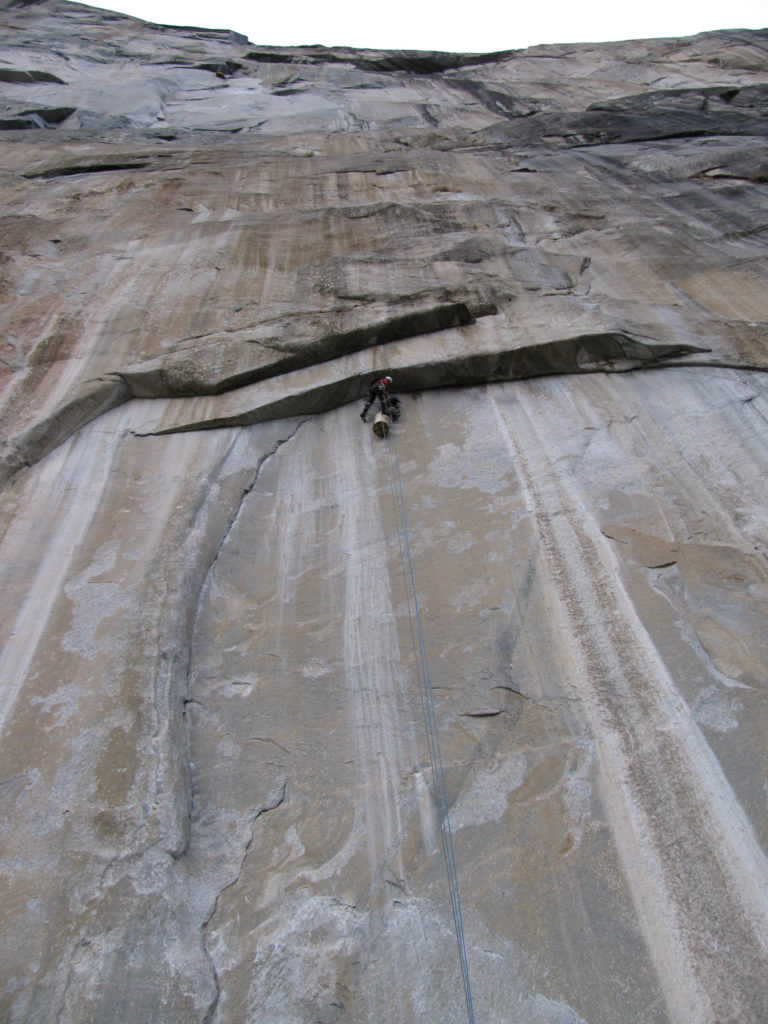
P1: Bob’s lead: Mostly straightforward, until you get just below the roof. It was 3 cam hook moves in a row to get to the anchors! When Bob unweighted the second hook move, it went “PING!!” and we both thought Bob was going airborne. It never happened, as the third hook held, and he made the anchors in style. We were both pleased that the hauling went smoothly!

P2: Ryan’s: A 50 foot C1 traverse under the roof, lead to some C2 hooking, micros, and a few awkward placements lead to the bolts. Don’t back clean if you want to keep your climbing partner around for next time!
After fixing and hauling the first two, we went down for food and our last night at camp 4. We never got a permit at camp 4, so Bob and I crammed in Larissa’s small alpine tent. Cramming three in a small two-person tent turned out to be good “training” for sleeping on the porta-ledge, and kept things very warm.
The next morning was “blast-off” day! We go up, and it was FREEZING! I decided to pack an additional hat and gloves. We went into the lodge for one last warm coffee and to procrastinate some more. An auxiliary goal was to go #2 one more time. Less weight and hassle on the wall is always a plus. We were both successful with the coffee but failed in the bathroom. Oh well, we will just have to deal with whatever came next.
We hiked and warmed up quickly, and soon the sun came out! w00t! Jugging to P2 went smoothly and without any issues. Or goal was four pitches a day.
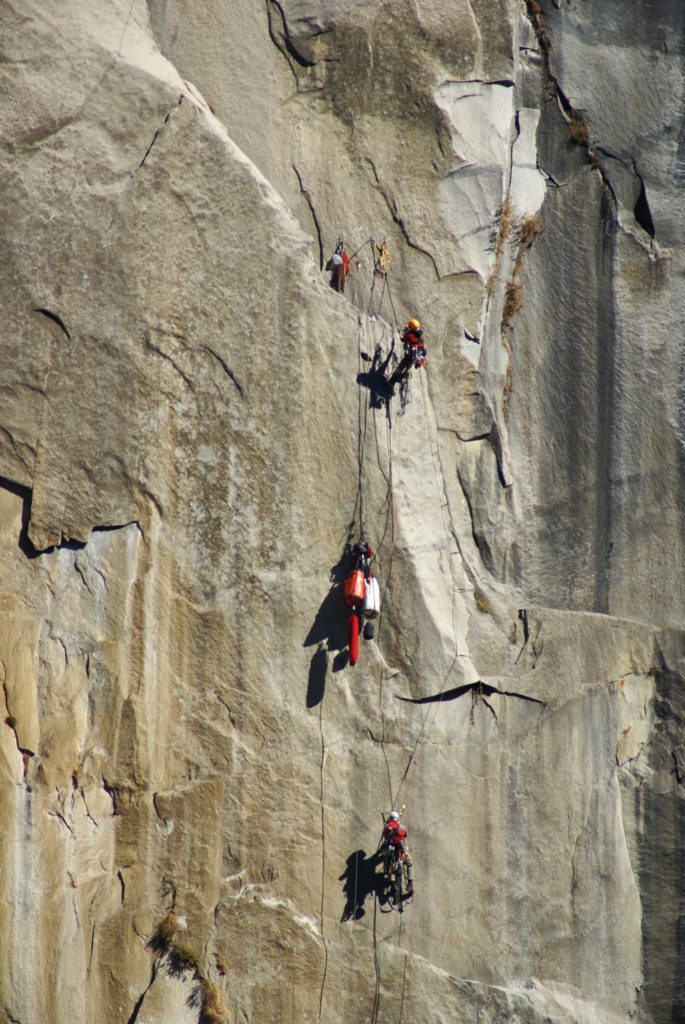
P3: Bob’s. Starts off the anchors with about 10 feet of hooking traverse, to a rivet ladder. He made it to “Dead Bird Ledge” in fine time. I looked like a nice place to sit and belay from. I wouldn’t know because I didn’t stay long.
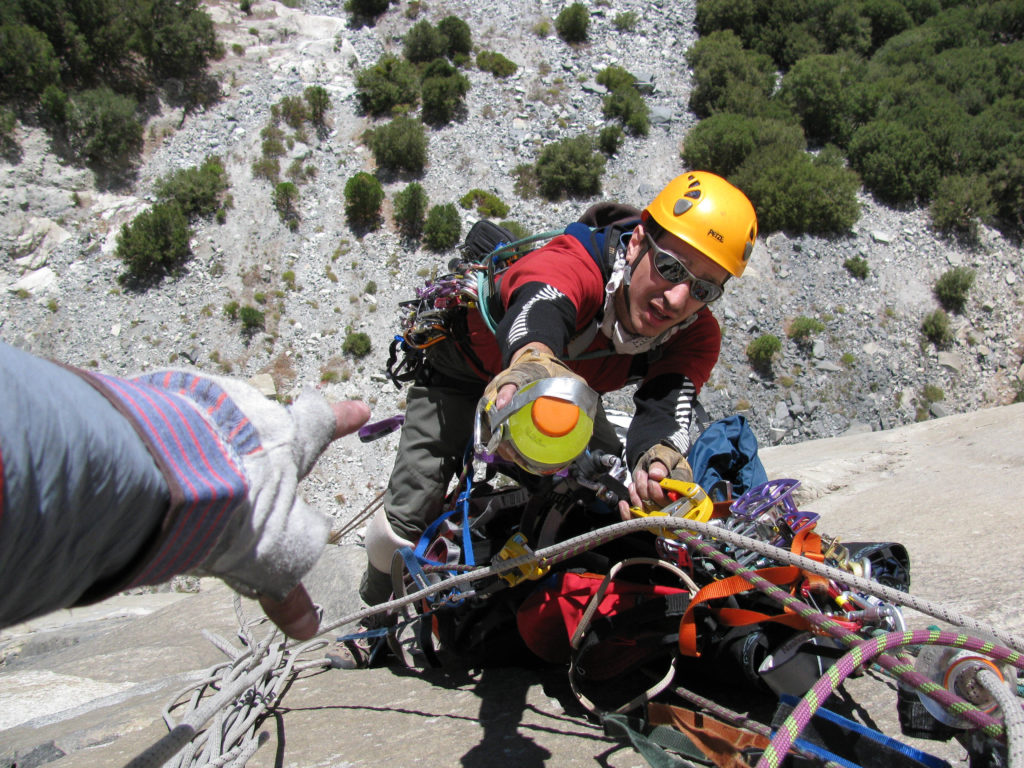
P4: Ryan’s: Supposed to be “5.6” to some C1, but with my awesome Hi-Tech wall boots, the large and heavy wall rack, that 5.6 felt really awkward and difficult. Later, I learned there is some “5.7” higher up that feels much easier. With enough grunting and thrashing, I made it to the cruiser C1 section. A big top step mantel move brought me to the semi-hanging anchors. Hauling went quickly.
P5: Bob’s: More hooking traverse lead to another bolt ladder to another good, flat stance. It looks like Bob is getting to belay from all the good stances!
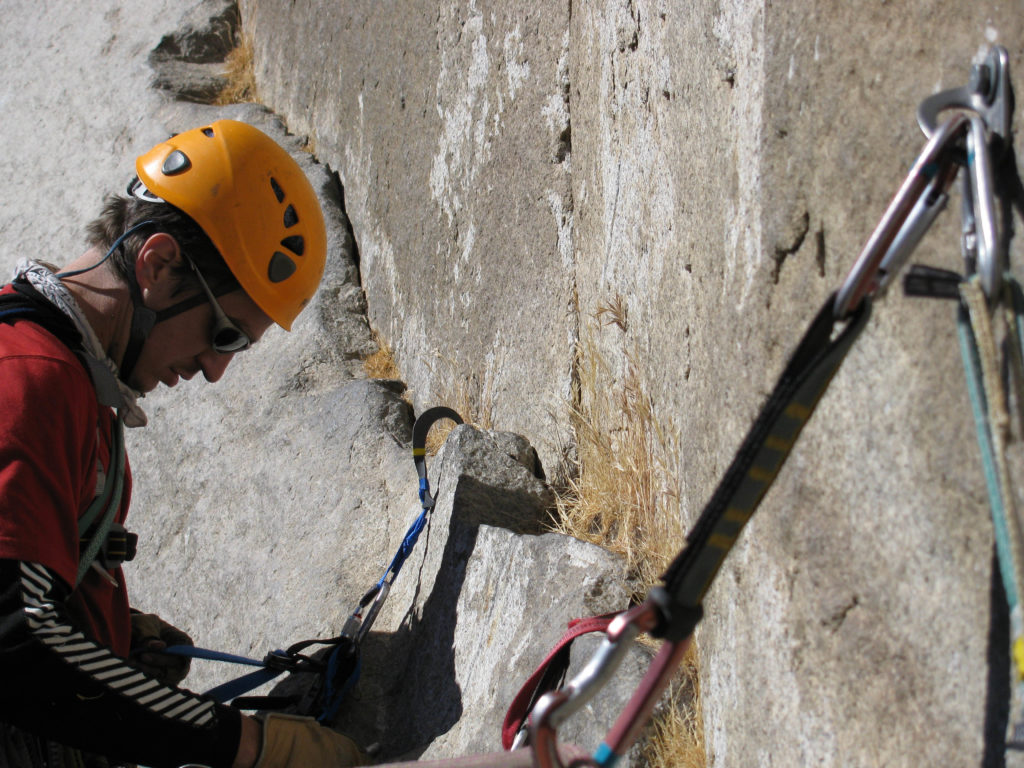
P6: Last pitch of the day! It started off with more 5.6, that was much easier than before. A few C1 moves lead to a scary dicey “inverted cam hook” move, that actually held! 40 feet of C1 lead to a nice comfortable, but small ledge. Bob and I deployed the portaledge and sorted out the rack way before the sunset! I argued for a long time that we should deploy the rain fly. I was totally paranoid about the cold, and anything to keep a little heat from blowing away in the wind. He somehow talked me out of it. We fell asleep in the warmish evening, and I anticipated waking up shivering in a few hours. But the cold never came! The sun came and I was actually warm all night! I guess the warming trend the forecast reported was coming true! I cannot tell you how relieved I felt to finally be warm in the morning. The Zodiac is positioned to get first light in the morning, which also helps a lot. I was even more motivated to climb this wall!
From that point, the climbing started to increase in difficulty and seriousness.
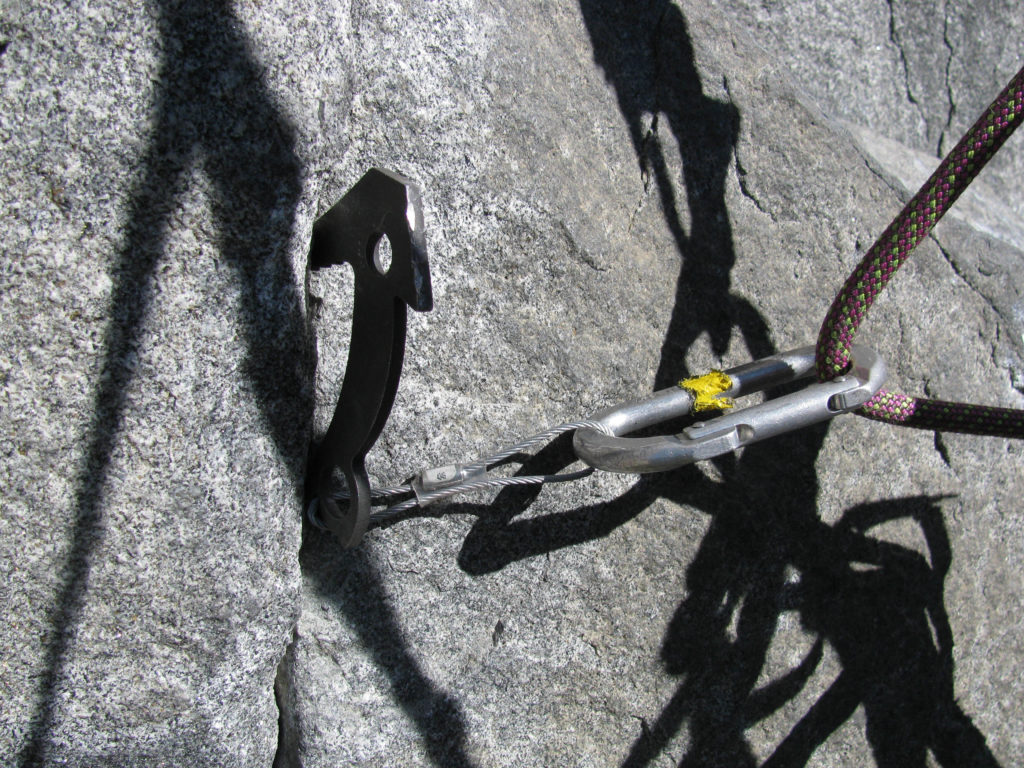
P7: Bob got to take on the famous “black tower” pitch. It started out pretty straightforward, about 50 feet of bomber C1 placements, then he turned the corner and slowed way down. I heard the occasional bit of hammering, and I only let out rope every few minutes. He shouted out more than once “watch me closely here!” Slowly and surely, he made the belay – at the comfortable 2’x5′ perfectly flat belay ledge. Turns out, last 2/3 of that pitch were solid C3 / A2+, and started with two equalized beak placements, right above the tower itself! Total Pucker fest!! Bob made good work out it, and got it without any incident. Great work! Here is where I learned the joy of cleaning beaks! I think each one took about 10 minutes to clean. They were probably over pounded, but I understood. I’m would have done the same thing. Safety is pretty high in my book, but that usually equates to a lot of work.
P8: I took the next crux pitch, that leads us into the steep white circle. Some 5.7 lead to some C1, then through a little roof and into some overhanging A2 stuff. You know how it goes (maybe): a brassy, to a cam hook, to a fixed head, to a fixed RURP, to a beak to another fixed head, to a brassy, to a fixed pin. A lot of fixed gear kept the fear level low, but the movement was deliberately slow. I’m sure I gained a few new white hairs on that one. A few reachy moves to a solid bolt and I let out a huge sigh of relief! The pitch leads to a nice 4 bolt, hanging anchor. I seemed to hit all the hanging ones.
P9: Tom Evans considers this the crux pitch of the white circle. Bob took it with confidence. It was long, but it was the first (and only?) pitch that went straight up, which made cleaning more enjoyable. He placed a lot of small gear one head. An amazing thing about that pitch was the chalk lines marking hundreds of small free holds. I guess Alex Hannold and Katie Brown attempted to climb the route free a few weeks before us. I think that pitch went at a moderate .13a or something. It was completely amazing to ponder freeing this route on those tiny holds with some thin wired bashies for protection! That looked _way_ beyond me.
The pitch leads to another hanging belay. It was about time Bob got to enjoy a hang!
It was late, and we were tired from the difficult leads. We decided to make camp there at the base of the famous nipple pitch. The Black Diamond ledge I brought makes setting up the hanging bivvy a breeze! They are so much easier to deploy than the “wind chime” style A5 ledges. On this particular bivvy, the wall was so steep, our ledge didn’t touch the wall! We were free hanging, gently swinging in the breeze! It made things a little dynamic without the suspension point of the wall. We quickly learned to announce our movements before any wiggling. I think that morning, I had to use the facilities. There is nothing like a free hanging bathroom to get the blood flowing in the morning. That activity on a portaledge always is an interesting endeavor.
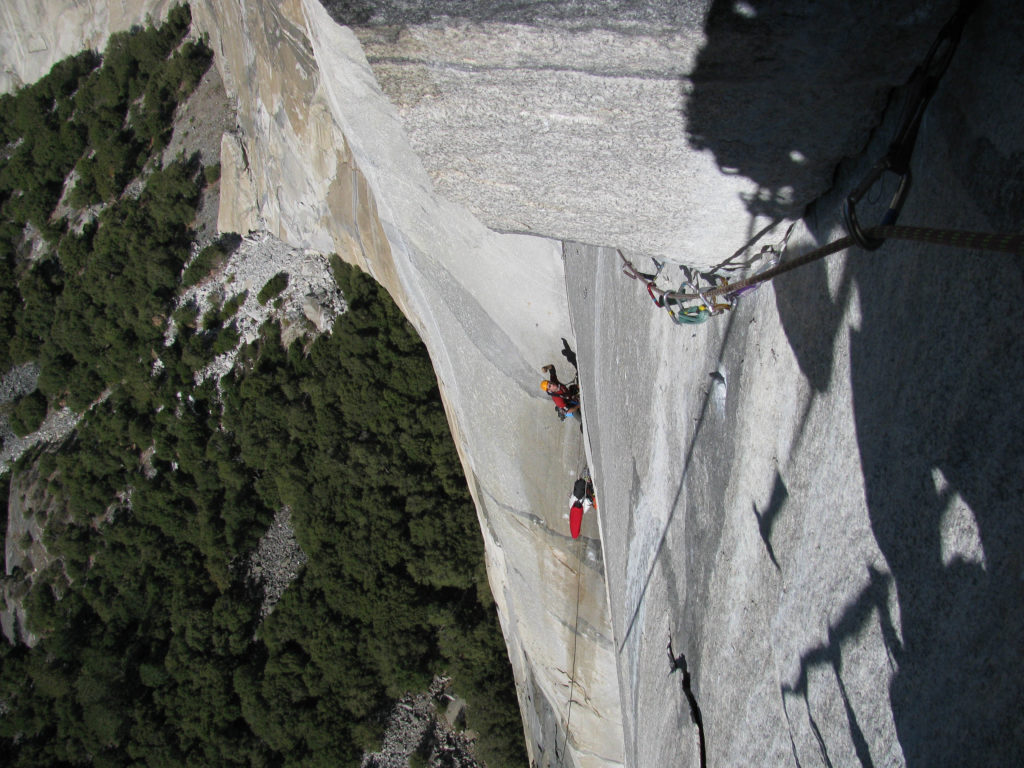
P10: I had to start the day by leading the nipple pitch. It started out easy enough, with some decent C1/2 placements between lots of fixed gear. Then I got to the nipple proper.
The tip of the nipple, the crack widened to about 18 inches. I called down for our wide gear kit, which went to 6 inches. I crammed as much wide gear as far out as I trusted, and the bolt was still about 2 feet beyond my reach. The large feature was pushing me down and out, and my gear was pulling me into the back of the wide crack and the bolt was in the complete opposite direction. This thing quickly turned into a full-bore bar fight. I had absolutely no idea how to get to that bolt. I would wiggle, re-arrange my gear, and wiggle some more. I cursed, sweat a lot, grunted, and every so often, checked my reach. The bolt was getting closer but still felt impossible to reach. To this day, I still have no idea how I clipped that bolt, but I eventually managed it! I did a celebratory grope of the nipple and was off. I quickly discovered the hard aid climbing came above the nipple! It was about 80 feet of C3 / A2 “Fixed Junk” that lead to the anchors. That pitch really threw all its punches at me! At least the last portion was straightforward, straight up aiding. A few hooks, brassies, pins, fixed heads, and a real scary cam hook move got me to the hanging anchors! I let out a huge rebel yell!
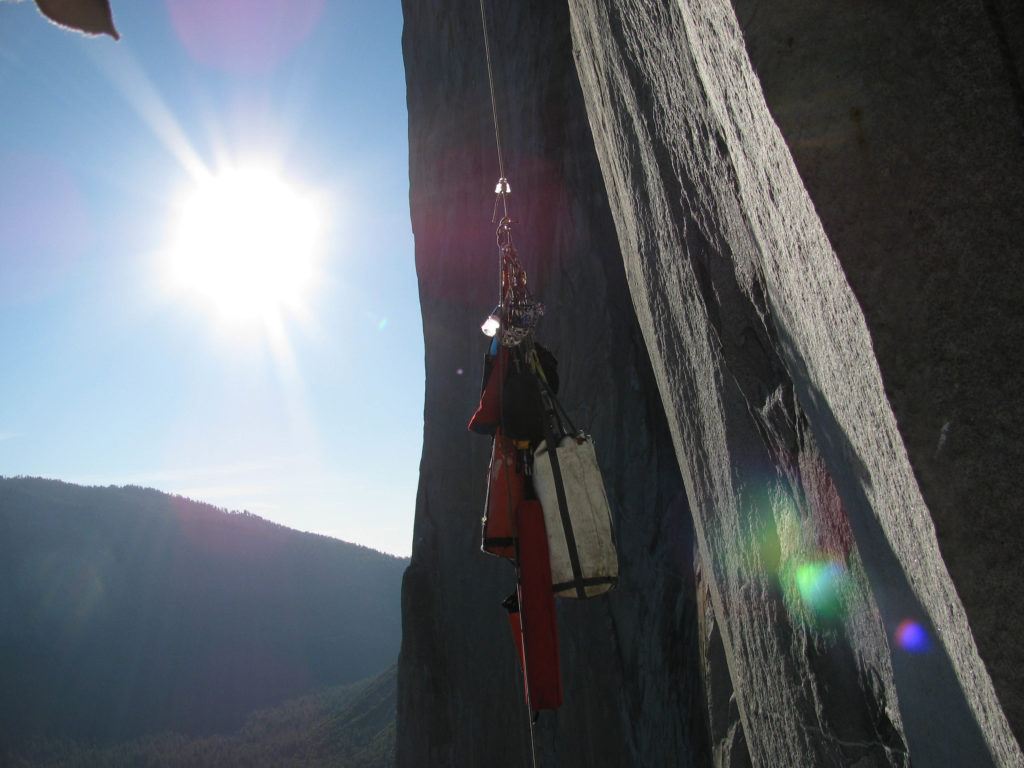
P11: Bob lead the “Mark of the Zorro”, to get us out of the overhanging white circle! It was steep! The pitch reminded me of the large roof at the top of the Leaning Tower. Bob didn’t have much trouble with the pitch, and despite its steepness, most the placements were C1-ish. Bob really had fun on that one. His comment was “It was like acro-yoga on a wall…. bitchin!!!!”
P12: I took the rack and set off as quickly as I could. The day was zooming by fast, and we had two more leads to get to “peanut ledge”. P11 started out straightforward with some fixed pins, then opened into some steep free moves to some large holds then into a bolt ladder. It was at the end where the 25-foot hooking traverse came it. I sucked it up and about 1/2 way through, I put the huge Pika hook behind a large block. The placement was decent enough, so when I stepped on the aider, I watched the 3-foot long block rock back a good inch! GASP!! Terror set in, as Bob was standing on a nice ledge directly below that block. That’s when I started to freak out. I couldn’t see a way through without using that block! I yelled down “Bob! Were EFFED!! Get the Cheater stick!!” I could sense Bob’s complete sigh of frustration. We didn’t have one, but in envisioned making one out of the fly poles and some duct tape. I didn’t even know where the rainfly poles were. Getting into the bags on a hang while belaying are usually the last thing anybody wants to do. I heard Bob working on it.
I started looking at the problem a little more clearly. I found a straight down angle -hand placed- to an inverted offset-alien with at least two good lobes…I thought it might work and that pin might hold a fall if it doesn’t… I canceled the order, and the alien held. _two_ more exciting hook moves lead to a fixed pin, to a bolt to the anchors!!! WOO HOO! I have never lead anything like that before. The sun went around the corner, and we still had one more pitch to go to stay on schedule.
P13: Bob was feeling better and willingly led us into the night to get to peanut ledge. The pitch was long but mostly C1. It got dark, so that slowed Bob down a little, but the climbing went at a nice steady pace. He did pause for a few minutes when he got to the now dubbed “detached prostitute flake”. You will have to personally ask him about that one.
Some interesting things about climbing in the night. Neither of us are very experienced in that. It seems that knowing the sun is setting, right before it finally goes down is the point of highest anxiety. But once it goes down, and we both surrendered to the reality of it, it was quite peaceful. In The Valley, the winds stop, after sunset, and the rock retains its heat from the day. Once settled into my bosons chair, I just relaxed, gently swinging into the anchors, and watched the cars go by. I scanned the wall for other climbers headlamps and could hear people playing the meadow, far below. It was a really nice time to be hanging out, thousands of feet up the wall. Soon enough Bob yelled “Off Belay!” and I cleaned the pitch quickly, and the bags were already to the anchors when I got there.
The bivvy on Peanut Ledge was really nice! It was a ledge, about 5 feet across and about 18″ wide, perfectly flat. The surface was sticky from the hundreds of climbers who make it there, and I think it is sheltered from rain, making some of that stickiness from Charley Porter himself! We put the pigs on the natural ledge and deployed our ledge about 10 inches above the peanut, making a very comfortable and flat home, with a place to stand up. The warm night was spent eating ravioli and drinking some fine boxed wine!
The sun hit my face first thing in the morning, a somewhat rude but warm jolt from my REM sleep. If all went right, it was to be the last day on the wall! After packing everything and using luxury accommodations, which always takes at least 30 minutes. The yells of encouragement from Bob didn’t speed things up much are but made for a great laugh.
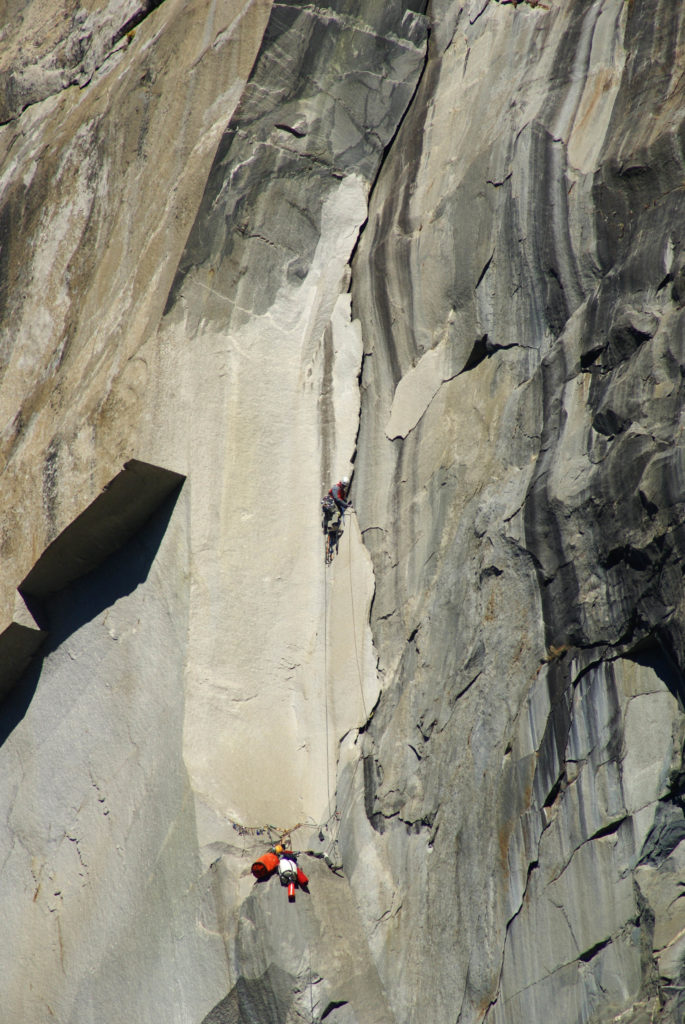
P14: I had this one. It a famous pitch that the TOPO states “80 feet of 4.5 inches”. We brought 2 #4s, 2 #5s, and 1 #6, just for this pitch! It turned out to be the right quiver for the job. The wideness was not the scary part. The scary, dangerous part was the looseness of the HUGE flake down low, and all the loose hollow corn-flake rock I had to cam behind for progress. The flake wheezed and moaned as I placed my weight on it. I watched the flake flex on each placement. When that thing goes, it’s going to be ugly. Lucky for all, the flake thickened and widened every move. Once about half way up, it melted into the Captain proper and felt much more secure. Crack jugging with the two #5s and the #6 was safe, and went fairly quickly. An awkward, down sloping roof, brought me around the corner to an exposed sloping perch with 3 solid belay bolts, 2,000 feet off the ground!
P15: Bob took this zig-zagging, wondering short pitch. It had an interesting hooking traverse and required a lot of back cleaning. He did a pretty good job, but still required some dynamic pendulum action for the cleaning. I did a few short “king swings” to get a couple cams out, but managed to get everything back. The pitch ended on yet another comfortable 3 foot by 30 foot ledge.
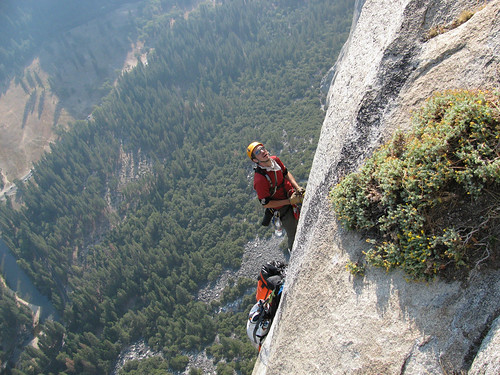
P16: I downed a Starbucks Double Shot and took off on some more free moves. The 4th class opening moves sort-of wigged me out, and I kept coming back to the anchors to find my head. The move was simple, but I was getting tired and felt really off balance with the silly 30-pound rack. I eventually figured it out, busted a few more free moves, sunk a few cams in, and did some more exciting moves on fixed heads, a fixed blade, to a hook to a weird #2 cam at my feet and more free moves, to the final, overhanging block! It was totally wild climbing! I knew I was going for the top, and that gave me a fresh energy! I could see the anchor bolts as I hung in the air at the top of the captain. At one point I looked down to back clean a piece, and I could see the starting rock at the base of the first pitch! That route is steep! Its reported to be “the best top out on the captain”, and I totally agree! What a finish!
I traversed around the block, clipped the final anchor, mantled onto the top and ran on flat ground to the large anchor tree!! WOO HOO!
It was here that I made a horrible decision. I used the tree as an anchor instead of the anchor bolts. This put tremendous friction on the haul line. I figured we could just build a 3 to 1 and get the pigs up. I fixed the line for Bob and started trying to haul. Even with the mechanical advantage, the bags would not move! Bob came up, and we worked together to haul. Even with the three to one, we could just barely move the pigs! Note to self, don’t let summit fever get in the way of the haul! It’s better to stay over the lip and take advantage of the less friction and body weight to haul. At one point some NIAID guys came by and saw our hauling system and commented “what? Did they remove the anchors from the edge?” After much sweat and swearing, we got the bags up! We were officially topped out on the Captain!
We were prepared to camp out on top. We had the right amount of water, the box of wine, and plenty of food. I can’t tell you how awesome it felt to get out of that harness and finally walk on flat ground. We sat, ate ravioli straight out of the can and watched the most amazing moon rise either of us has seen. It was an absolutely perfect night, after a perfect climb!
More links!





